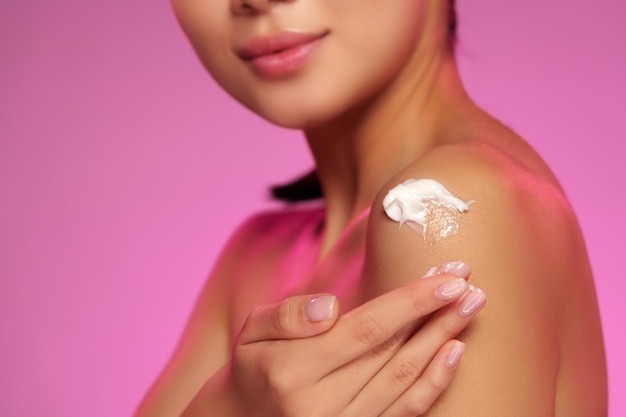Sensitive skin needs a skincare routine that protects your barrier, reduces irritation, and supports hydration without flooding your face with unnecessary active ingredients. In 2025, the best skincare routine for sensitive skin focuses on minimal but effective steps, avoiding triggers like fragrances, harsh exfoliants, and reactive preservatives.
The goal is not to overload your skin but to maintain a calm, resilient barrier. If you deal with redness, tightness, or burning after using products, switching to a barrier-first, fragrance-free routine with gentle hydration and sun protection will likely give you the most noticeable improvement.
In 2025, we now have access to barrier-repairing ingredients like Centella Asiatica, ceramides, and microbiome-balancing postbiotics in well-formulated, minimal products, making it easier than ever to maintain healthy, comfortable skin without reactions.
Why Sensitive Skin Needs a Different Approach

Sensitive skin often has a compromised barrier that allows irritants to penetrate easily, leading to inflammation. This means the wrong cleanser, an overused exfoliant, or a harsh sunscreen can trigger burning, stinging, or redness.
In 2025, common triggers include:
- Fragrance (even natural essential oils)
- Denatured alcohol
- Overuse of strong acids (AHAs, BHAs)
- Harsh surfactants in cleansers
- Layering too many actives without monitoring skin response
The best approach involves limiting ingredients, supporting the barrier, and using consistent hydration and sun protection.
Core Routine for Sensitive Skin in 2025
Here is a table summarizing the ideal sensitive skin routine with recommended ingredients and their benefits:
| Step | Purpose | Recommended Ingredients | What to Avoid |
|---|---|---|---|
| Gentle Cleanser | Remove dirt without stripping the barrier | Non-foaming, pH-balanced cleansers with glycerin | Sulfates, high pH soaps |
| Hydrating Toner (optional) | Light hydration, prep skin | Panthenol, hyaluronic acid, Centella Asiatica | Alcohol-based toners |
| Moisturizer | Lock in moisture, repair the barrier | Ceramides, squalane, fatty acids | Heavy fragrance, essential oils |
| Sunscreen | Protect from UV damage | Mineral SPF with zinc oxide or titanium dioxide | Chemical sunscreens that cause stinging |
| Treatment (if needed) | Address specific concerns | Niacinamide (low %), azelaic acid | Strong acids, retinoids without guidance |
Choosing Each Step in Detail
1. Cleansing Without Compromising
Sensitive skin often becomes worse with harsh cleansers. Look for a non-foaming, creamy, or gel cleanser that is fragrance-free and pH-balanced around 5.5. Micellar waters can also work if rinsed off with lukewarm water. Cleansing should be done once at night, and in the morning, rinsing with water alone may suffice.
2. Moisture Without Irritation

Your moisturizer should replenish what your skin lacks. Choose a fragrance-free, simple moisturizer containing ceramides, cholesterol, and fatty acids. These ingredients mimic your skin’s natural barrier and help repair it. Squalane is lightweight and beneficial for sensitive skin, while shea butter can be soothing if your skin tolerates heavier creams.
3. Sun Protection Is Essential
Sensitive skin is often more prone to sun-induced damage, which worsens redness and irritation. Mineral sunscreens (zinc oxide, titanium dioxide) are typically better tolerated by sensitive skin. Modern mineral sunscreens in 2025 now have lightweight, non-chalky formulas, making daily use easier and more comfortable.
Active Ingredients: What You Can Use and What to Avoid
While sensitive skin often reacts to active ingredients, some can be beneficial in low concentrations:
- Niacinamide (2–5%): Helps with redness and strengthens the skin barrier.
- Azelaic acid (10%): Helps with redness and acne without the irritation of typical acids.
- Centella Asiatica: Calms inflammation and supports healing.
Avoid strong exfoliants unless under guidance. Instead, use a soft washcloth once or twice a week for gentle exfoliation if needed.
If you struggle to find products your skin tolerates, consider consulting a skincare professional or a makeup artist experienced with sensitive skin to help you identify non-irritating formulas that pair well with your daily routine.
A skilled makeup artist can guide you in choosing skin-safe makeup products that align with your skincare efforts, helping you maintain a calm barrier while looking your best without irritation.
This can be particularly helpful if you need to wear makeup regularly for work or events, ensuring your skincare and makeup work together rather than against each other.
Example Of a Routine
| Time | Step | Product Example |
|---|---|---|
| Morning | Rinse with water or a gentle cleanser | Non-foaming cleanser |
| Moisturizer | Ceramide cream | |
| Sunscreen | Mineral SPF 30+ | |
| Evening | Gentle cleanser | Same as morning |
| Hydrating toner (optional) | Alcohol-free toner | |
| Treatment (if needed) | Niacinamide serum | |
| Moisturizer | Same or richer cream |
Adjusting and Monitoring Your Skin
The best skincare routine for sensitive skin is one that you can stick to consistently without reactions, not one that changes every few days. Your skin needs stability to repair its barrier and learn to tolerate products without flare-ups.
If you decide to try a new product, perform a patch test on your jawline or behind your ear for at least 3–5 days before applying it to your entire face. Watch for any signs of redness, itching, or burning, which indicate the product may not be suitable for you.
When adding a new product, introduce only one at a time and give your skin at least two weeks to adjust before introducing another step. This allows you to pinpoint what works and what may trigger reactions without overwhelming your skin. Keep a simple skincare journal to track what you use and how your skin responds, noting any redness, dryness, or improvements.
If you notice persistent redness, burning, visible blood vessels, or eczema-like patches that do not improve with a gentle routine, it’s important to consult a dermatologist. You may have a condition like rosacea or perioral dermatitis that needs targeted medical treatment rather than over-the-counter skincare alone.
Professional guidance can help you manage sensitive skin effectively, ensuring your routine supports, rather than harms, your skin’s health long-term.
Future Trends Benefiting Sensitive Skin in 2025

In 2025, sensitive skin care benefits from:
- Microbiome-friendly formulations that support your skin’s natural bacteria.
- Barrier-first brands focus on minimal ingredient lists.
- Fragrance-free advanced sunscreens with comfortable finishes.
- Peptide-rich creams that help soothe and repair without irritation.
These trends make it easier to build a routine that prioritizes your skin’s health, reduces irritation, and helps you feel confident in your daily care.
As innovation grows, at home facial tools and skincare devices powered by red light, micro-current, and infrared therapy are becoming more accessible for sensitive skin users looking for gentle improvements.
Conclusion
Choosing the best skincare routine for sensitive skin in 2025 means prioritizing your skin’s comfort over chasing fast results. A gentle, consistent routine focusing on cleansing, hydration, and sun protection will stabilize your skin barrier, reduce sensitivity, and allow your skin to become stronger and more resilient over time. By using well-formulated cosmetics and skincare products and monitoring your skin’s response, you give yourself the best chance to keep your sensitive skin clear, calm, and healthy.




